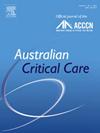危重病护理护士焦虑、抑郁、压力、工作倦怠与睡眠障碍特征的危险因素:一项观察性研究。
IF 2.6
3区 医学
Q2 CRITICAL CARE MEDICINE
引用次数: 0
摘要
目的/目的:本研究的目的是确定危重病护理护士的焦虑、抑郁、压力和工作倦怠之间的危险因素和关联,并描述睡眠障碍。环境:数据收集于6个重症监护病房。方法:采用描述性横断面设计。采用多变量和单变量回归来确定重要的危险因素。结果:共纳入140名重症护理护士。女性与高焦虑水平相关(优势比[OR] = 3.03;95%置信区间[CI] = [1.12-8.23];p = 0.029),抑郁(OR = 10.55;95% ci = [2.17-51.19];p = 0.003)、应力(OR = 2.87;95% ci = [1.02-8.07];p = 0.045)。多因素回归显示,有离职意向的重症护理护士的焦虑水平较高(OR = 3.65;95% ci = [1.40-9.53];p = 0.008),抑郁(OR = 6.79;95% ci = [2.01-22.95];p = 0.002),应力[OR = 4.13;95% ci = [1.49-11.45];p = 0.006),倦怠(OR = 4.15;95% ci = [1.63-10.56];p = 0.003)。睡眠质量受高潜伏期、低持续时间、药物使用和白天功能障碍的影响。结论:女性患焦虑、抑郁和压力等心理健康问题的风险高于男性。离开的意图是焦虑、抑郁和压力的独立预测因素。睡眠潜伏期高、持续时间短、使用药物和白天功能障碍等特征对睡眠质量有负面影响。心理健康的早期检测将使护理管理人员能够实施非药物预防干预措施,以改善工作中的幸福感。本文章由计算机程序翻译,如有差异,请以英文原文为准。
Risk factors of anxiety, depression, stress, job burnout, and characteristics of sleep disorders in critical care nurses: An observational study
Aim/Objective
The aim of this study was to determine risk factors and associations between anxiety, depression, stress, and job burnout and describe sleep disorders in critical care nurses.
Setting
Data were collected in six intensive care units.
Methods
A descriptive cross-sectional design was used. Multivariate and univariate regressions were used to determine significant risk factors. Significance levels were established at p <0.05. We use Depression Anxiety Stress Scales to determine anxiety, depression, and stress. Work burnout was detected using the Maslach Burnout Inventory scale, and sleep quality was determined by the Pittsburgh Sleep Quality Index.
Results
A total of 140 critical care nurses were included. The female gender was associated with high levels of anxiety (odds ratio [OR] = 3.03; 95% confidence interval [CI] = [1.12–8.23]; p = 0.029), depression (OR = 10.55; 95% CI = [2.17–51.19]; p = 0.003), and stress (OR = 2.87; 95% CI = [1.02–8.07]; p = 0.045). Multivariate regression showed that critical care nurses with intention of leaving were exposed to high levels of anxiety (OR = 3.65; 95% CI = [1.40–9.53]; p = 0.008), depression (OR = 6.79; 95% CI = [2.01–22.95]; p = 0.002), stress [OR = 4.13; 95% CI = [1.49–11.45]; p = 0.006), and burnout (OR = 4.15; 95% CI = [1.63–10.56]; p = 0.003). Sleep quality is influenced by high latency, low duration, the use of medications, and daytime dysfunction.
Conclusion
Females were exposed to a higher risk of developing mental health problems such as anxiety, depression, and stress than men. The intention to leave was an independent predictor of anxiety, depression, and stress. Characteristics such as high sleep latency, low duration, use of medications, and daytime dysfunction have a negative impact on sleep quality. Early detection of mental health would allow nursing managers to implement nonpharmacological preventive interventions to improve well-being at work.
求助全文
通过发布文献求助,成功后即可免费获取论文全文。
去求助
来源期刊

Australian Critical Care
NURSING-NURSING
CiteScore
4.90
自引率
9.10%
发文量
148
审稿时长
>12 weeks
期刊介绍:
Australian Critical Care is the official journal of the Australian College of Critical Care Nurses (ACCCN). It is a bi-monthly peer-reviewed journal, providing clinically relevant research, reviews and articles of interest to the critical care community. Australian Critical Care publishes peer-reviewed scholarly papers that report research findings, research-based reviews, discussion papers and commentaries which are of interest to an international readership of critical care practitioners, educators, administrators and researchers. Interprofessional articles are welcomed.
 求助内容:
求助内容: 应助结果提醒方式:
应助结果提醒方式:


